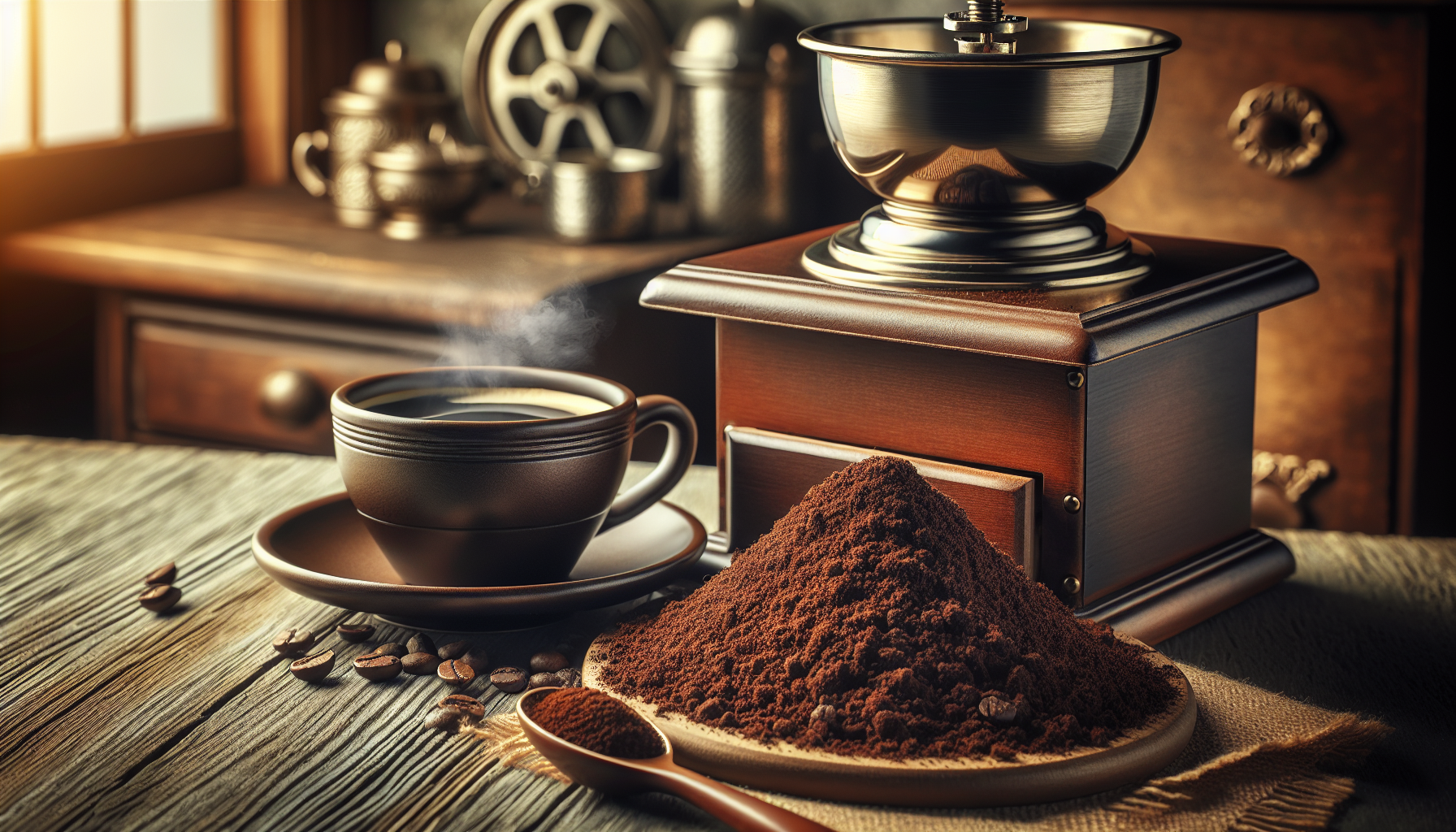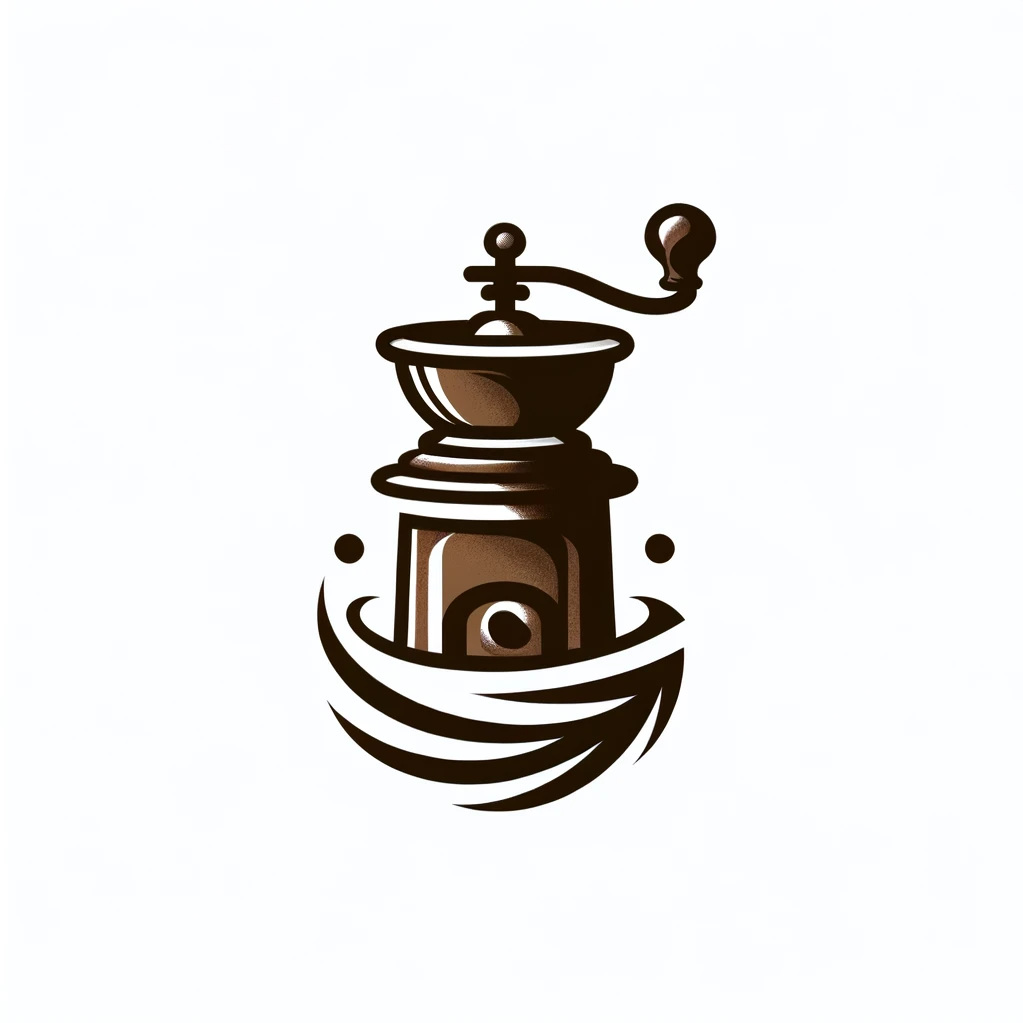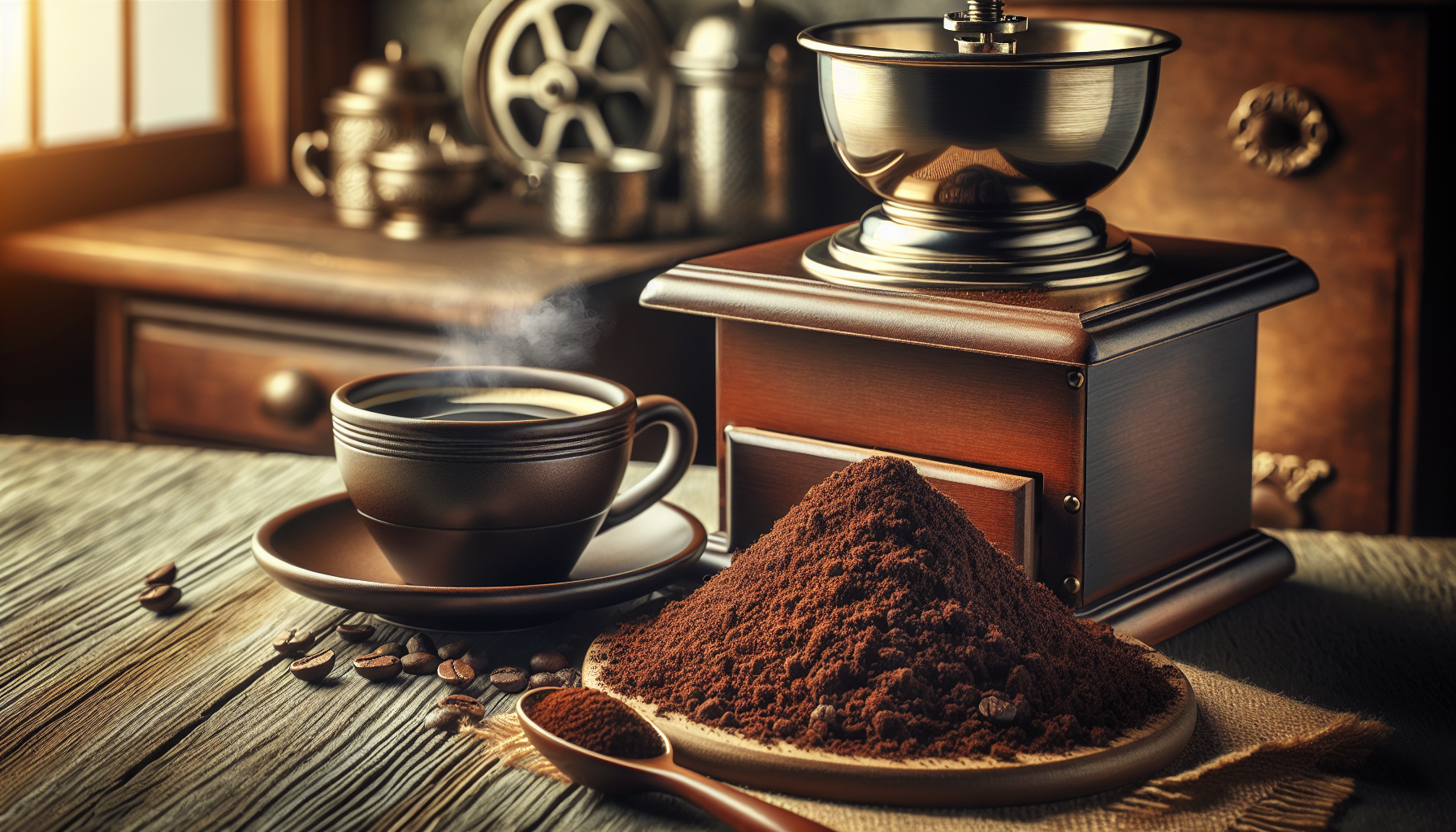Coarse grinding coffee is a crucial step in achieving a bold and flavorful cup of joe. Whether you’re an avid coffee lover or just getting started with brewing, knowing how to coarse grind your coffee beans can make all the difference. In this article, we will guide you through the process, sharing tips and techniques to help you achieve the perfect grind for your preferred brewing method. So grab your favorite beans, dust off your grinder, and get ready to elevate your coffee game to a whole new level. Let’s dive into the world of coarse grinding coffee!

CHECK OUT COFFEE GRINDERS ON AMAZON
Choosing the Right Coffee Grinder
When it comes to achieving the perfect cup of coffee, one of the most important factors to consider is the grind size. And to achieve the ideal coarse grind, you need the right coffee grinder. There are two main types of coffee grinders to choose from: blade grinders and burr grinders.
Blade Grinders
Blade grinders are the most common and affordable option for home coffee enthusiasts. As the name suggests, these grinders use sharp rotating blades to chop the coffee beans into smaller particles. While blade grinders are relatively easy to use and readily available, they do have some drawbacks. One significant drawback is that they can produce an inconsistent grind size. The blades tend to create a mixture of fine and coarse particles, resulting in an uneven extraction and potentially a less flavorful cup of coffee. However, if you have a limited budget and are not overly concerned about precision, a blade grinder can still produce a decent coarse grind.
Burr Grinders
For those who are serious about their coffee and want to achieve a consistent, high-quality coarse grind, a burr grinder is the way to go. Burr grinders use two revolving abrasive surfaces, known as burrs, to crush the coffee beans into a uniform size. The adjustable nature of burr grinders allows you to select the desired grind size accurately, ensuring an even extraction and maximizing flavor. While burr grinders tend to be more expensive than blade grinders, they are well worth the investment for coffee enthusiasts who crave a consistently excellent cup of coffee.
Understanding Coarse Grind
What is Coarse Grind?
Before delving into the importance of coarse grind, let’s clarify what it actually means. Coarse grind refers to the larger particle size of coffee grounds that are suited for specific brewing methods. While espresso typically requires a fine grind, coarse grind is more suitable for methods like French press, cold brew, and percolators. Coarse grind results in bigger coffee particles, which allow for a slower extraction process and create a bolder, full-bodied flavor.
Why is Coarse Grind Important?
Coarse grind plays a crucial role in extracting the flavors and aromas from coffee beans. If the grind size is too fine, it can lead to overextraction, resulting in a bitter and unpleasant taste. On the other hand, if the grind size is too coarse, the extraction may be insufficient, resulting in a weak and watery brew. Therefore, achieving the right coarse grind is essential for maximizing the flavor potential of your coffee beans and ensuring a delicious cup of joe.
Ideal Coffee Brewing Methods for Coarse Grind
Different brewing methods call for different grind sizes, and knowing which methods are best suited for coarse grind can greatly enhance your coffee brewing experience. Here are a few popular brewing methods that work exceptionally well with a coarse grind:
-
French Press: The French press method involves steeping coarsely ground coffee in hot water and then separating the coffee grounds from the liquid with a plunger. The coarse grind allows for a slow and thorough extraction, resulting in a rich and full-bodied cup of coffee.
-
Cold Brew: Cold brew is a brewing method that involves steeping a large quantity of coarsely ground coffee in cold or room temperature water for an extended period, typically around 12-24 hours. The coarse grind size helps extract the flavors slowly, resulting in a smooth and less acidic coffee concentrate.
-
Percolators: Percolators have long been a favorite brewing method for many coffee lovers. With percolators, hot water is forced through a chamber containing a basket of coarsely ground coffee. The water percolates through the grounds multiple times, resulting in a strong and robust cup of coffee.
By choosing the right brewing method for your coarse grind and understanding how grind size impacts the extraction process, you can elevate your coffee brewing game and enjoy a truly exceptional cup of coffee.
Step-by-Step Guide to Coarse Grinding Coffee
To achieve a perfect coarse grind, follow these simple steps:
1. Measure the Coffee Beans
Start by measuring the desired amount of coffee beans based on your preferred strength and the brewing method you’ll be using. A general rule of thumb is to use one to two tablespoons of coffee per six ounces of water.
2. Adjust the Grinder Settings
If you’re using a burr grinder, adjust the grind settings to a coarse setting. This will ensure that the coffee beans are ground into the desired size for a coarse grind. If you’re using a blade grinder, you won’t have the same level of control over the grind size, but you can still achieve a coarse grind by pulsing the grinder in short bursts.
3. Load the Coffee Beans
Once you’ve measured the coffee beans and adjusted the grinder settings, load the beans into the grinder’s hopper or chamber. It’s important not to overload the grinder to ensure a consistent and even grind.
4. Start Grinding
Turn on the grinder and let it grind the coffee beans. For blade grinders, it’s best to pulse in short bursts to achieve a more even grind. For burr grinders, simply let it run until all the coffee beans have been ground.
5. Check the Consistency
After grinding the coffee beans, take a moment to inspect the resulting grounds. The ideal coarse grind should have larger, uniform particles. If you notice any excessively fine particles, you may need to adjust the grinder settings or re-grind the beans to achieve a more consistent coarseness.
6. Adjust and Re-Grind if Needed
If the grind size isn’t to your liking, you can make adjustments accordingly. For burr grinders, simply adjust the settings to achieve a finer or coarser grind. For blade grinders, you may need to experiment with pulsing for shorter or longer durations to achieve the desired coarseness.
By following this step-by-step guide, you’ll be able to consistently achieve a perfect coarse grind for your favorite brewing methods.
Tips for Coarse Grinding
While the step-by-step guide provides a solid foundation for coarse grinding, here are some additional tips to enhance your coffee grinding experience:
Choosing the Right Roast
When it comes to coarse grinding, medium to dark roasts tend to yield the best results. These roasts have a balanced flavor profile and can handle the longer extraction time required for coarse grind brewing methods. Light roasts, on the other hand, may result in a weak and under-extracted brew.
Maintaining a Clean Grinder
Regularly cleaning your coffee grinder is crucial for ensuring consistent and flavorful grind results. Coffee oils and residue can accumulate over time, affecting the grinder’s performance and the taste of your coffee. Refer to your grinder’s user manual for specific cleaning instructions.
Experiment with Grind Time
If you’re using a blade grinder, adjusting the grind time can help you fine-tune the coarseness of the grind. Experiment with pulsing for shorter or longer durations to achieve the desired particle size.
Avoid Overgrinding
Overgrinding can lead to a fine and powdery texture, which is not ideal for a coarse grind. Pay close attention to the grind consistency to avoid overgrinding, as this can result in a bitter and over-extracted cup of coffee.
Use a Timer
To maintain consistency in your coffee grinding, consider using a timer. This will help you achieve the same grind time for each batch of coffee beans, resulting in a more predictable and enjoyable brewing experience.
By keeping these tips in mind, you can fine-tune your coarse grinding skills and consistently brew a delicious cup of coffee.
Common Mistakes to Avoid
While coarse grinding may seem straightforward, there are a few common mistakes that you should be aware of and avoid:
Grinding Too Fine
One of the most common mistakes when attempting a coarse grind is accidentally grinding the coffee beans too fine. This can happen when the grinder’s settings are not adjusted correctly or if the grinding time is too long. Always double-check the consistency of your grind to ensure it’s coarse enough for your chosen brewing method.
Inconsistent Grinding
Inconsistent grinding can result from blade grinders or unevenly distributing the coffee beans in the grinder’s hopper. It’s important to load the beans evenly and pulse the blade grinder in short bursts, or adjust the burr grinder settings to ensure a consistent grind size throughout.
Neglecting the Grinder Maintenance
Coffee grinders, like any other kitchen appliance, require regular maintenance to perform optimally. Neglecting to clean and maintain your grinder can lead to a build-up of coffee residue and affect the quality of your grind. Be sure to follow the manufacturer’s instructions for cleaning and maintenance to keep your grinder in top shape.
By being mindful of these common mistakes, you can achieve a reliable and consistent coarse grind that will enhance the flavor of your coffee.
Best Coffee Beans for Coarse Grinding
The quality of the coffee beans you choose for coarse grind can greatly impact the flavor of your coffee. Here are a few factors to consider when selecting coffee beans for coarse grinding:
Single Origin Beans
Single origin beans are often favored for specialty coffee brewing methods, including coarse grind. These beans are sourced from a specific geographic region and offer unique flavor profiles that can be fully appreciated with a slower extraction process.
Dark Roasts vs. Light Roasts
As mentioned earlier, medium to dark roasted beans tend to be better suited for coarse grinding. Dark roasts have a bolder flavor profile that can withstand the longer extraction time, resulting in a more robust cup of coffee. Light roasts, while still suitable for some brewing methods, may impart a subtler flavor that can be overshadowed by the coarse grind extraction.
Flavor Profiles for Coarse Grind
When selecting coffee beans for coarse grinding, consider the flavor profiles that complement the brewing method. For example, for a French press, you might opt for beans with chocolate or nutty undertones. For cold brew, you may prefer beans that exhibit fruity or floral notes. Experimentation with different beans and flavors can help you discover your favorite combinations.
By exploring various coffee beans and paying attention to their roast levels and flavor profiles, you can enhance the overall taste experience of your coarse grind coffee.
How to Store Coarse Ground Coffee
Once you’ve achieved the perfect coarse grind, it’s essential to store your coffee properly to maintain its freshness and flavor. Here are some tips for storing coarse ground coffee:
Choosing the Right Container
Invest in an airtight and opaque container specifically designed for storing coffee. These containers help protect the coffee from air, light, and moisture, preserving its flavor for a longer period. Avoid using transparent or glass containers as they can expose the coffee to light, which can degrade the taste over time.
Keeping Away from Moisture
Moisture is the enemy of coffee freshness, so it’s crucial to store your coarse ground coffee in a dry environment. Avoid storing it near the sink or any other sources of moisture. Additionally, refrain from storing the container in the refrigerator, as the moisture and odors can seep into the coffee, negatively impacting its flavor.
Avoiding Direct Sunlight
Just as with whole beans, coarse ground coffee should be kept away from direct sunlight. Exposure to sunlight can accelerate the staling process and lead to a faster deterioration of the coffee’s flavor. Store your coffee container in a dark and cool pantry or cupboard to protect it from harmful UV rays.
Avoiding Oxygen Exposure
Oxygen is another factor that can degrade the quality of your coffee over time. To minimize oxygen exposure, ensure that the container is airtight and always seal it tightly after each use. The less air that interacts with the coffee, the longer it will retain its freshness and flavor.
Freezing vs. Room Temperature
While it’s generally recommended to store whole beans in a cool, dark place, the same may not hold true for coarse ground coffee. Due to its larger surface area, ground coffee is more susceptible to moisture and odor absorption. Therefore, freezing coarse ground coffee is not recommended, as the condensation that occurs during freezing can negatively affect the flavor. Instead, store your coarse ground coffee at room temperature in an airtight container for optimal freshness.
By following these storage tips, you can ensure that your coarse ground coffee remains fresh and full of flavor until your next brew.
Alternative Methods for Coarse Grinding
If you find yourself without a coffee grinder, there are alternative methods for achieving a coarse grind. While they may not provide the same level of precision as a dedicated grinder, they can still get the job done.
Using a Mortar and Pestle
A mortar and pestle are commonly used in cooking, but they can also be used for grinding coffee beans. Simply add a small amount of coffee beans to the mortar and use the pestle to crush them into a coarse grind. This method requires some manual effort, but it can be a fun and satisfying way to grind coffee without a grinder.
Blender or Food Processor
If you have a blender or food processor on hand, you can also use it to achieve a coarse grind. Add the coffee beans to the blender or food processor and pulse in short bursts until you reach the desired grind size. However, be cautious not to overblend, as this can result in an inconsistent grind.
While these alternative methods may not provide the same level of control or consistency as a dedicated grinder, they can be handy in a pinch and allow you to enjoy a freshly brewed cup of coffee.
CHECK OUT COFFEE GRINDERS ON AMAZON
Common Questions and Answers
Can I use a blade grinder for coarse grinding?
Yes, a blade grinder can be used to achieve a coarse grind, although it may not produce the same level of consistency as a burr grinder. To achieve a coarse grind with a blade grinder, pulse the grinder in short bursts to prevent overgrinding and aim for a uniform particle size.
Can I use pre-ground coffee for a coarse grind?
Pre-ground coffee is typically already ground to a specific size, so using it for a coarse grind might not yield the desired results. It’s best to grind your coffee beans fresh for optimal flavor and control over the grind size.
Can I use a regular grinder but adjust the settings to a coarser setting?
If you have a regular grinder with adjustable settings, you can certainly adjust it to achieve a coarser grind. However, keep in mind that not all grinders offer the same level of precision in grind size adjustments, so you may need to experiment to find the optimal settings for a coarse grind.
How long does it take to grind coffee coarse?
The duration of grinding for a coarse grind can vary depending on the grinder, the quantity of coffee beans, and the desired coarseness. It’s recommended to grind in short bursts or pulses and periodically check the consistency to avoid overgrinding. Experimentation and practice will help you determine the optimal grinding time for your specific grinder and desired grind size.
Experimenting with Coarse Grind
Now that you have a solid understanding of coarse grind and its impact on flavor and brewing methods, let’s explore how you can experiment with it to enhance your coffee experience.
Grind Size vs. Brew Strength
One factor to consider when experimenting with coarse grind is the brew strength. By adjusting the grind size, you can vary the strength of your coffee. Finer grinds tend to result in a stronger brew, while coarser grinds can produce a milder cup. By experimenting with different grind sizes, you can find the perfect balance that suits your taste preferences.
Grind Size vs. Extraction Time
Another aspect to consider is the extraction time. Coarser grinds typically require a longer brewing time due to the larger particle size. By extending the extraction time, you can extract more flavor compounds from the coarse grind and create a more robust cup of coffee. Conversely, a shorter extraction time can result in a lighter and more delicate brew.
Taste Differences with Various Brewing Methods
Lastly, try brewing the same batch of coarse ground coffee using different methods to explore the taste differences. French press, cold brew, percolators, and other coarse grind-friendly brewing methods each offer unique flavor profiles. Pay attention to the nuances in taste and aroma that each method brings out, and discover which one resonates with your palate.
By experimenting with different grind sizes, extraction times, and brewing methods, you can unlock a world of flavors with coarse ground coffee.
In conclusion, achieving the perfect coarse grind is essential for maximizing the flavor potential of your coffee beans. Whether using a blade grinder or investing in a burr grinder, follow the step-by-step guide and implement the tips mentioned to ensure a consistent and delicious grind. Pay attention to the roast level and flavor profiles of your chosen coffee beans, and store them properly to maintain freshness. And don’t be afraid to experiment and explore the world of coarse ground coffee to discover your ideal brewing methods and taste preferences. Happy brewing!

